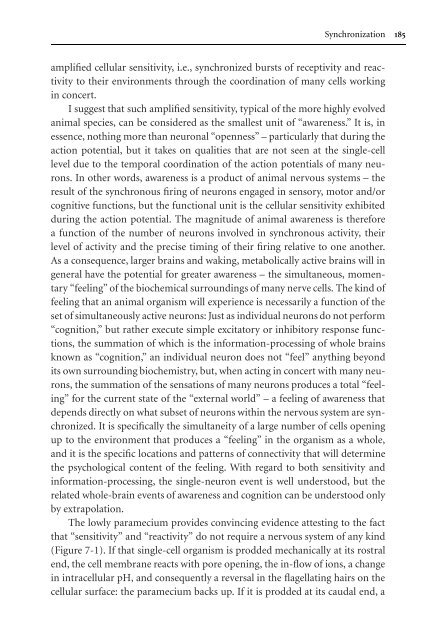Tone of Voice and Mind : The Connections between Intonation ...
Tone of Voice and Mind : The Connections between Intonation ...
Tone of Voice and Mind : The Connections between Intonation ...
You also want an ePaper? Increase the reach of your titles
YUMPU automatically turns print PDFs into web optimized ePapers that Google loves.
Synchronization 185<br />
amplified cellular sensitivity, i.e., synchronized bursts <strong>of</strong> receptivity <strong>and</strong> reactivity<br />
to their environments through the coordination <strong>of</strong> many cells working<br />
in concert.<br />
I suggest that such amplified sensitivity, typical <strong>of</strong> the more highly evolved<br />
animal species, can be considered as the smallest unit <strong>of</strong> “awareness.” It is, in<br />
essence, nothing more than neuronal “openness”–particularly that during the<br />
action potential, but it takes on qualities that are not seen at the single-cell<br />
level due to the temporal coordination <strong>of</strong> the action potentials <strong>of</strong> many neurons.<br />
In other words, awareness is a product <strong>of</strong> animal nervous systems – the<br />
result <strong>of</strong> the synchronous firing <strong>of</strong> neurons engaged in sensory, motor <strong>and</strong>/or<br />
cognitive functions, but the functional unit is the cellular sensitivity exhibited<br />
during the action potential. <strong>The</strong> magnitude <strong>of</strong> animal awareness is therefore<br />
a function <strong>of</strong> the number <strong>of</strong> neurons involved in synchronous activity, their<br />
level <strong>of</strong> activity <strong>and</strong> the precise timing <strong>of</strong> their firing relative to one another.<br />
As a consequence, larger brains <strong>and</strong> waking, metabolically active brains will in<br />
general have the potential for greater awareness – the simultaneous, momentary<br />
“feeling” <strong>of</strong> the biochemical surroundings <strong>of</strong> many nerve cells. <strong>The</strong> kind <strong>of</strong><br />
feeling that an animal organism will experience is necessarily a function <strong>of</strong> the<br />
set <strong>of</strong> simultaneously active neurons: Just as individual neurons do not perform<br />
“cognition,” but rather execute simple excitatory or inhibitory response functions,<br />
the summation <strong>of</strong> which is the information-processing <strong>of</strong> whole brains<br />
known as “cognition,” an individual neuron does not “feel” anything beyond<br />
its own surrounding biochemistry, but, when acting in concert with many neurons,<br />
the summation <strong>of</strong> the sensations <strong>of</strong> many neurons produces a total “feeling”<br />
for the current state <strong>of</strong> the “external world” –a feeling <strong>of</strong> awareness that<br />
depends directly on what subset <strong>of</strong> neurons within the nervous system are synchronized.<br />
It is specifically the simultaneity <strong>of</strong> a large number <strong>of</strong> cells opening<br />
up to the environment that produces a “feeling” in the organism as a whole,<br />
<strong>and</strong> it is the specific locations <strong>and</strong> patterns <strong>of</strong> connectivity that will determine<br />
the psychological content <strong>of</strong> the feeling. With regard to both sensitivity <strong>and</strong><br />
information-processing, the single-neuron event is well understood, but the<br />
related whole-brain events <strong>of</strong> awareness <strong>and</strong> cognition can be understood only<br />
by extrapolation.<br />
<strong>The</strong> lowly paramecium provides convincing evidence attesting to the fact<br />
that “sensitivity” <strong>and</strong> “reactivity” do not require a nervous system <strong>of</strong> any kind<br />
(Figure 7-1). If that single-cell organism is prodded mechanically at its rostral<br />
end, the cell membrane reacts with pore opening, the in-flow <strong>of</strong> ions, a change<br />
in intracellular pH, <strong>and</strong> consequently a reversal in the flagellating hairs on the<br />
cellular surface: the paramecium backs up. If it is prodded at its caudal end, a


